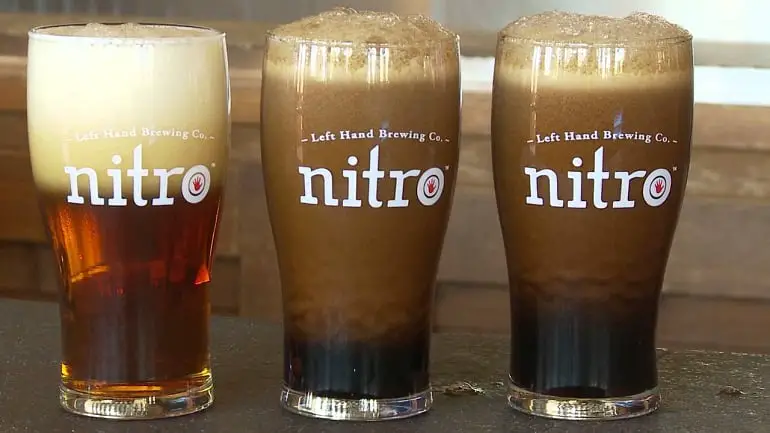Table of Contents
*This post may contain affiliate links. As an Amazon Associate we earn from qualifying purchases.
Craft breweries never cease to amaze, and the introduction of nitro beer to the stout world proves that. Utilizing nitrogen taps is a craze catching on like wildfire to those that love smooth, creamy, dark beer. You can find these ingenious pours popping up all over the country, but what is it that makes this process so uniquely delicious?
This method is shrouded in science and mystery, as if it were a magic potion from craft greats like the Sierra Nevada, Yards Brewing Company, Sixpoint, and others. If you’ve ever wondered what nitro beers are or how they’re concocted, then this article was made just for you. If you’ve ever wondered how in the world this craze caught on and why it is so popular, then read on.
Nitrous Oxide

What is nitro beer? Well, the term nitro refers to the type of gas used in the carbonation process. Adding nitrous oxide into the mix creates a creamier version of the stouts so many love, creating a more luxurious experience than ever thought possible with CO2. Your average nitrogenized beer reduces the carbon dioxide content down to thirty percent and makes up the remaining difference with nitrogen.
Unlike carbon dioxide, nitrogen is incapable of being dissolved in liquid. This contributes to both the creamier texture and frothy head associated with nitro beer. Beer is forced through a restrictor plate in the tap, which pushes it through tiny holes, causing the rising effect that gives nitro variants their immense head.
During the restrictor process, carbonation is added. Using nitrogen allows for the bubbles in your suds to be smaller in size, giving stouts the freedom the be the thick creations they deserve to be. If you’ve ever tried a nitro milk stout, then the difference between this process and the carbon dioxide version is unmistakable. CO2 variants are aggressive on the tongue and heavy on the aroma, while N2 versions offer more evenly distributed flavors.
An excellent example is the Left-Hand Milk Stout Nitro, crafted by Left Hand Brewing Company in Colorado. They had created a milk stout over a decade ago but revamped their recipe in 2011 for an unveiling at the Great American Beer Festival.
If you’re an experienced beer drinker, then you will notice that any brew poured through a nitro tap results in a stronger malt flavor as opposed to a happy one. While other styles have given this pour a try, stouts and porters benefit the most from this process. Another notable feature is the cascading effect when being poured into a glass, caused by the tinier bubbles.
The Real Difference

Whether you choose to have your beer of choice poured through a carbon dioxide or nitro tap, the taste will be incredibly similar so long as it is a porter or stout. The most significant difference is how it feels in the mouth. Expert brewers call the resulting experience from a CO2 tap “carbonic bite,” which refers to the stinginess that many darker beers are known for.
The second difference can be found in the head of the beer. A stout poured from a CO2 tap will feature a bubbly, slowly receding head. Those poured from N2 taps will create a much thicker, off-white head on top that lasts much longer.
Nitro beer tends to have a greater nose and a more roasted taste, resulting from the diminished bitterness of the hops. Guinness has been utilizing nitrogen for decades, which should give you a decent beer to base the difference in regular stouts off of. However, each breweries creation will come out unique on the other side of the nitro tap.
It is essential to keep in mind that aspects of taste and aroma are all perceived differently. Even top critics in the beer industry tend to disagree on their experiences with a bottle. That being said, the above information is the general consensus on how nitrogen changes a beer. It is highly recommended to try the same beer side by side, one-poured from a nitro tap and the other from a traditional.
Why Are Nitro Taps Catching on Now?

While Guinness had figured out a way to nitrogenize their brew a long time ago, the majority of craft brewers found it challenging to incorporate the gas into their product. There was also the discovery that pale ales and lighter beers didn’t translate well at all. Others had a difficult time securing nitrogen cables for their taps, which hard to find until around five years ago.
There also exists a crowd of beer enthusiasts who strongly oppose nitro beer. These proponents of classic carbon dioxide claim that nitrogen does not stay in the solution long enough to keep the beer from going flat. Others are simply fans of hoppy IPA’s or believe that nitrogen is a fad used to sell less than desirable beer.
Given that this group exists, it’s easy to see how many breweries were worried about alienating part of their existing customer base. However, no fan of stouts who has ever tried a nitro milk version has ever complained. As for the beer going flat in a short time, this is just not true.
The process of infusing the drink with nitrogen creates that thick, creamy head that nitro beer drinkers love. Given that the liquid is now so vicious, the nitrogen bubbles actually float down to the bottom of the glass. This is something that Left-Hand Brewing will tell you first hand.
As technology increased, brewers were ready to try something new. Thus, the age of nitro beer was born. It might not be the best option for every beer on the market, but those looking to perfect stouts have found that it makes a world of difference.
The Nitro Process

Have you ever wondered what the rattling ball inside of a can of Guinness was for? That’s how the company adds nitrogen into the beer, causing the head to form after you crack open the can. Different companies use different methods, though.
Most breweries or microbreweries will infuse nitrogen into their kegs to make the process simple. As beer is drawn outwards, it mingles with the N2 to create an ideal pour from the tap. Others, like Sam Adams, have chosen to go with the can method.
Unlike Guinness, these cans are already infused with nitrogen that will result in a head when poured into a glass. Companies like Left Hand have chosen to do the same with their bottles. Regardless of the method, they taste best when poured from a tap as the nitrogen combines with the beer at the last possible moment.
That’s not to say that these other methods of nitrogenization aren’t delicious, though. Below are some excellent examples of companies leading the charge in the nitro revolution.
Top Nitro Beers
To get you started on your nitro quest, here are some of the top-rated beers whose makers utilize the N2 process. Left Hand’s Milk Stout Nitro has already covered been above, but absolutely include it in this list.
Nitro Vanilla Porter by Breckenridge Brewery

This beer infuses dark malt, cocoa, and cola aromas into a black-amber concoction. The same flavors you smell are the ones you’ll taste. While this beer looks incredibly thick, it remains light-bodied and refreshing for a porter.
Polygamy Nitro Porter by Wasatch Brewery

Save this one for a cold winter night. Heavy chocolate and bread on the nose come through with sweet hints trailing behind in this oh so smooth porter. It’s enough to warm your spirits even in frigid temperatures.
Red Velvet by Ballast Point Brewing Co.

A non-traditional oatmeal stout, the flavor tastes exactly as the name suggests. The amber color and earthy tones come from the incorporation of beets in the brewing process, while the spiciness remains a mystery.
Nitro Coffee Stout by Sam Adams

If you’re already a fan of coffee stouts but leery of Sam Adams, then prepare to be surprised. The can say it all with the line, “pop and pour.” This is an excellent way to relax after work, and it pairs nicely with a medium-bodied cigar.
Changing the Game
Nitro beers remain largely experimental but show immense promise in the realm of stouts and porters. If Guinness can make it a staple in their recipe, then who’s to say that the world won’t be treated to even darker, creamy beers in the years to come? Now that you know what a nitro beer is, get out there and try a nitrogenized version of one of your favorites.

